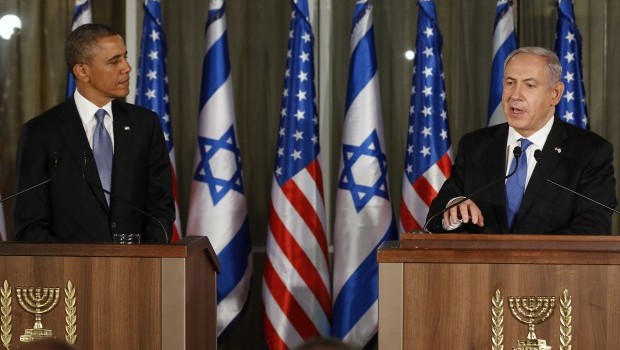After US President Barack Obama’s visit to Israel, which was scheduled to coincide with Iranian celebrations marking the Persian New Year (Nowruz), it seems that the mythical Battle of Armageddon is approaching. However, the Hidden Imam has not reappeared. Shi’ite eschatology talks of a conflict that will rage before Doomsday—the end of time—between the forces of good and evil on a mountain called “Armageddon”, where a decisive battle will take place between the two sides.
As soon as he assumed power, President Ahmadinejad started talking about the return of the Hidden Imam—Abu Al-Qasim Ibn Muhammad—who is said to have vanished from sight in 329 Hegira (941 CE). In his speech before the UN General Assembly in September 2005, Ahmadinejad expounded on the imminent return of the imam, leaving Western diplomats bemused. He hinted that the return of the Hidden Imam was imminent, saying that soon, God willing, Iran would be the focal point of the global leadership. The Iranian president has also asserted in the past that even the enemies of Iran now know that the return of the Mahdi is inevitable, claiming that the world’s superpowers are “stunned” as a result. Ahmadinejad has also remarked that the Hidden Imam has played a role in Iran’s transformation into a nuclear power.
In 2006, Dar al-Ilm Publishing House in Beirut published a book entitled “Ahmadinejad and the New World Revolution”. It was written by Shadi Faqih and distributed by Lebanon’s Hezbollah. In it, the author talks about the relationship between Ahmadinejad and the returning imam, and claims that the latter will liberate Jerusalem. Faqih goes on to say that we are now living in the age of the imam’s reappearance, and as the date of his return approaches, Ahmadinejad will become the commander of his forces and Supreme Guide Ali Khamenei the standard bearer. The book claims that after Ahmadinejad was elected president, the Iranian Council of Ministers struck an agreement with the Hidden Imam and a letter stipulating the terms was thrown into the well of Jamkaran, near Qom, requesting the imam’s return. However, Faqih explains that before he is to reappear, Iran must first become a nuclear power since the atomic bomb is the modern-day equivalent of the holy fire the Persians used to light in their temples before the advent of Islam. They considered this holy fire to be a symbol of their god Ahora Mazda, who represented light to them.
In his first trip since his re-election, Barack Obama arrived in Israel two days after Benjamin Netanyahu formed his new government. Despite the past differences between the two men, clear signals were made by the two sides that the time has come to deal with the Iranian nuclear issue. Before leaving Washington, the US President said that it is time for Iran to take “immediate and significant steps” to reduce the tension between it and the international community regarding its nuclear program. Obama appealed to Iran to resolve its differences with Washington and other Western countries. He said, “Iran’s leaders say that their nuclear program is for medical research and electricity. To date, however, they have been unable to convince the international community that their nuclear activities are solely for peaceful purposes”.
In west Jerusalem, Netanyahu announced before the Knesset—after his government had won the approval of the parliament—that his new government’s priority is to defend Israel. The Israeli prime minister added that Iran is doing its utmost to enrich uranium, but—as he pointed out in September—there is a red line that it cannot cross.
The US president and the Israeli prime minister have differed with regards to what exactly this “red line” is. However, Obama recently told a television station that Iran is one year way from being able to produce a nuclear bomb and thus the two men have limited time to deal with the issue decisively.
There are two options now: Either the US and Israel can allow Iran to produce a nuclear bomb or they can strike its reactors to prevent this from happening. Since Ahmadinejad’s presidential term is likely to end in mid-June, it seems that the decisive battle between good and evil will take place after his departure, and most likely after Obama has approved an Israeli military strike against Iran’s nuclear installations without any reference to Washington in this regard.

What a conclusion and wishful thinking but I’d say” dream on ” ain’t happening and Iran will move forward in its path to democracy and liberalization and once that happened in a few years since democracy takes time, then Iran will be a strong and vibrant democracy and best friend to our beloved USA unlike Arabs.
Let me get this straight. A book distributed by Hezbollah claims that Iranian nuclear weapons represent the so-called “holy” fire of the pre-Islamic pagan god, ahora mazda?
I also do not understand why the author cares about whether Ahmadinejad is in office. The Supreme Guide, Ali Khamenei, controls the nuclear program, Hezbollah, the IRGC and Iran’s expansionist policies. Ahmadinejad, who cannot even prevent his relatives and friends from being arrested by Khamenei loyalists, is a distraction. The world watches Ahmadinejad, but he is not the one who sets military policy and foreign policy for the Islamic Republic of Iran.
As for Jerusalem: if Iran uses nuclear weapons against Jerusalem, they will vaporize the Mosque and slaughter 300,000 innocent Arab Muslim civilians. This would not exactly be “liberating,” would it? Even Assad hasn’t killed 300,000 Arabs (yet). Has anyone, in all of history, EVER massacred 300,000 innocent Arab civilians? Not to mention the other 500,000 innocent civilians who live in Jerusalem. This would not be a “liberation.” It would be a genocidal slaughter, a war crime of the first magnitude, the most conscienceless atrocity in the history of the middle east. In such a context, one might be entitled to talk about “good” and “evil”, but the IRI would certainly NOT be on the side of “good.”